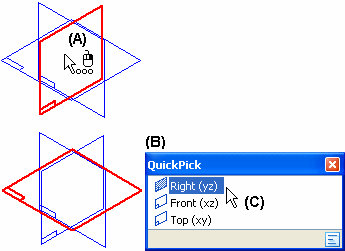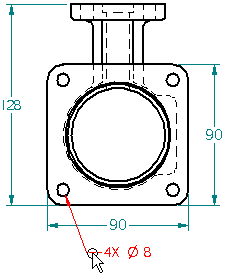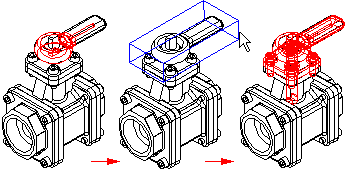Element and object selection
Selecting elements and objects—such as lines, arcs, dimensions, annotations, features, reference planes, reference axes, parts, subassemblies—tells QY CAD that you want to perform operations on them. Some commands are available only when you have selected an element first. For example, before you can select the Copy command, you must select something to copy. Other commands prompt you for selections as they run. When you select the Trim command, for example, you are prompted to select one or more elements to trim.
When the Select command is running  and you select an element or object, the following things happen:
and you select an element or object, the following things happen:
-
Its color changes to the selection color. You can change this color with the QY CAD Options dialog box.
-
For some types of elements, one or more handles are displayed, so you can manipulate the element.
-
For some types of elements, properties and the operations you can perform on the element are displayed on a command bar.
For more information on the types of handles available and how you can use them, see the Help topic, Handles overview.
Selection sets
You can select any number of elements and objects at once. Operations such as delete, move, copy, and rotate affect all selected elements simultaneously. The collection of elements or objects that is currently selected is called the selection set.
Selecting with QuickPick
If you want to select an element that you cannot easily highlight with the cursor, you can use QuickPick.
You can display QuickPick by moving the cursor onto overlapping elements and pausing until the QuickPick prompt appears. The prompt indicates which mouse button to click (A). The default is to right-click.

In the QuickPick list (B), move your cursor over the items to highlight individual elements in the graphics window (C).

Setting QuickPick options
You can click the Options button  in the QuickPick list to specify whether the left or right mouse button displays the QuickPick list. You can also set other defaults for QuickPick, such as the number of items that are displayed in the list, how long it takes to display the prompt, and the width and height of the list.
in the QuickPick list to specify whether the left or right mouse button displays the QuickPick list. You can also set other defaults for QuickPick, such as the number of items that are displayed in the list, how long it takes to display the prompt, and the width and height of the list.
For more information, see QuickPick Options dialog box.
Selection filters
You can use the Home tab→Select group→Selection Filter  list to control element selection. For example, when selecting with a fence, you can choose Uncheck All to remove all the elements from the selection set, and then select only the specific elements you want to include. Or, you can choose Reset to return all of the elements to their default state so you can specify which items you want to exclude.
list to control element selection. For example, when selecting with a fence, you can choose Uncheck All to remove all the elements from the selection set, and then select only the specific elements you want to include. Or, you can choose Reset to return all of the elements to their default state so you can specify which items you want to exclude.
Locate zone for 2D selections
In the Draft environment, the cursor is an arrow with a locate zone indicator at the end.

As you move the cursor, any element that the locate zone passes over is displayed in the highlight color. When an element is highlighted, you can click to select it.

In the Draft environment, you can restrict the types of items that are located using the Select Options dialog box, which is available from the Draft, Profile, and Sketch Selection command bar.
Selecting parts adjacent to a part
In the Assembly environment, you can drag the cursor to create a 3D selection box. You can use the 3D Box Select option on the Selection Manager menu to create a 3D selection box around a selected part. The 3D box selects additional parts that are in the proximity of the first part.

For more information on defining select sets using the Selection Manager Mode command, see Defining select sets in synchronous parts and assemblies.
Selecting parts based on part size
You also can select parts in an assembly based on their size. To do this, use the Select Parts by Size button  on the Home tab in the Select group. Then use the Part size box on the command bar to control the size of the parts that are selected and highlighted.
on the Home tab in the Select group. Then use the Part size box on the command bar to control the size of the parts that are selected and highlighted.
Selecting visible parts
You can select parts in an assembly based on whether they are partially or completely visible. To select all visible parts, use the Select Visible Parts button  on the Home tab in the Select group.
on the Home tab in the Select group.
Selecting with search criteria
Use the Home tab→Select group→Find Components command  to select parts in an assembly by defining search criteria based on the document properties of the parts in the assembly.
to select parts in an assembly by defining search criteria based on the document properties of the parts in the assembly.
For example, you can create a select set of parts that have a particular material property defined, such as stainless steel.
You can also search by criteria using the Query dialog box to first define the query parameters of interest. The query is saved using a name you define and is added to the Select Tools tab in PathFinder.
When you want to use the query to find and select parts that match the query parameters, double-click the query name on the Select Tools tab. Parts that match the query are selected in the assembly window.
For more information, see Find a part in an assembly.
Using handles to manipulate selected 2D elements
Handles are solid circles at significant positions on a selected drawing element, such as end points and center points. Use handles to directly modify the element—drag a handle to change the element's shape. Although you can select more than one element at a time, only one element can have handles displayed at a time.
For more information, see Handles overview.
© 2021 UDS